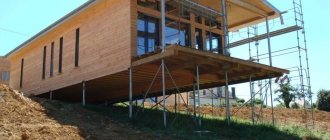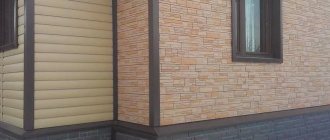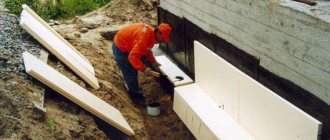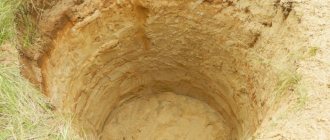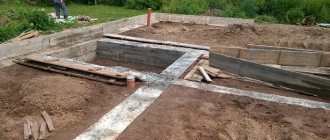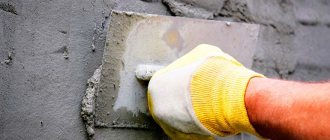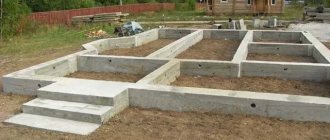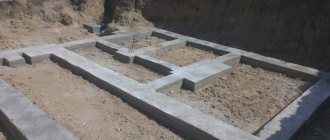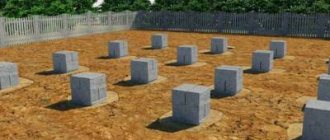A wide selection of materials is available for cladding the façade plinth.
Options for the best way to decorate the foundation base of a private house beautifully and cheaply are discussed in the article.
How to cover the foundation of a house from the outside cheaply and beautifully: materials, photos, prices
There is no point in indicating the specific cost of each solution, since prices for materials, as well as specialist services, differ in different regions. But you can consider budget solutions that allow you to solve the issue at the lowest possible cost:
- Basement siding is made of PVC and is not afraid of moisture and temperature changes. Suitable for both strip and pile foundations, as it can be mounted on a wooden or metal frame. The most important advantage: the work is easy to do yourself, which saves money.
- Flat slate is another cheap material that works well for plinths; it can be used to quickly level the surface and create bases for any type of finish. This option is not considered the safest, but when used outdoors it is unlikely to harm the health of residents.
- Corrugated sheeting can be used to cover the foundation. The material is durable and easy to use, but the appearance of the structure will not be the most attractive. Therefore, this solution is most often used for country houses, outbuildings and other structures where the aesthetic component is not very important.
- Coloring. You can simply paint the base if the surface is more or less flat. Minor unevenness and damage can be plastered or puttied. For the job, it is worth choosing high-quality paint that creates a moisture-proof layer on the surface.
- Plastering. If the house has a strip foundation or a block base, you can finish it with a plaster compound to protect it from adverse influences and give it an attractive appearance. It is best to use compounds with pigment that do not need to be painted, then the work can be done in one go.
By the way!
The base should be finished as early as possible so that the structure does not become saturated with moisture and deteriorate. In the case of a pile foundation, this is not so important, but in this case the appearance of the house without finishing will not be very attractive.
Which ones are inexpensive?
How to sheathe the base inexpensively? Inexpensive materials include:
- OSB boards.
- DSP.
- Decorative panels.
- Siding.
OSB boards are the cheapest, their cost is from 450 rubles, DSP - 850 rubles with a length of 320 cm. The price of siding starts from 368 rubles, and decorative panels can be ordered for 427 rubles.
Tips from experts on how to properly and inexpensively decorate the basement of a house with your own hands are presented here.
You will find all the most important, interesting and useful information about finishing the basement in this section.
Plaster
Suitable for concrete surfaces, block structures and other prefabricated elements. The work can be done independently, but if you need to create a certain structure, it is better to practice beforehand. If you don’t know how to cover the strip foundation of a house from the outside cheaply and beautifully, then this solution will be optimal, as it has many advantages:
- Availability. The price of plaster compositions is low; they can be bought at any hardware store.
- Easy to apply. To work, you will need a container for preparing the mixture, a trowel and a small rule for leveling the surface. All features of the process are indicated on the packaging.
- Short terms of work. Finishing the foundation of an average-sized home can be completed in a day.
- Possibility of painting the surface in a suitable color.
There are also disadvantages that are worth considering:
- You need to purchase special plaster; regular façade plaster will begin to crack in a couple of years.
- The surface must be dry and clean, so work cannot be carried out during wet periods.
- If the foundation has significant unevenness, the consumption of plaster increases greatly.
If necessary, you can first fix the thermal insulation material; extruded polystyrene foam is best suited. And a reinforcing mesh must be laid on top of the sheets.
Concrete
The so-called decorative concrete is facing elements in the form of bricks, tiles or natural stone. They are attached to the base with an adhesive composition and not only transform it, but also serve as additional protection from adverse influences. The main advantages are:
- Low price. Products made from lightweight concrete are much cheaper than other facing materials.
- Ease of use. You can carry out the work yourself; no special qualifications are needed.
- Possibility of painting in any color, although the elements can be with the addition of pigment.
As for the disadvantages, we can highlight the following:
- Concrete absorbs moisture, which is undesirable, so the surface should be treated annually with a special protective agent.
- The size of the products is small, so cladding can take a lot of time.
Important!
When using decorative concrete, it is important that the base is dry. To improve adhesion, be sure to treat it with a special primer.
Covering the base: a necessity or a decorative element?
For most people, the exterior design of a house is one of the important points during its construction. Such nuances are discussed in advance with builders, designers and architects.
Covering the base with decorative tiles
However, few people know that plinth cladding is not only about decorating cold, sloppy concrete. Finishing work initially has a completely different purpose:
- Protecting the foundation from damage. Colonies of fungi or mold can grow on concrete over time. Also, the base is not protected from damage by corrosion and erosion. Constant rain, snow, frost or heat contribute to the appearance of cracks and splits, which in turn threatens the integrity of the building.
- Protection against contamination. The environmental situation in the world contributes to the fact that acid rain falls, and polluted air contains elements that destroy even concrete. If the base often succumbs to such contamination, then very soon it will begin to collapse beyond repair. The consequence will be irreparable destruction of the house. Cladding saves the foundation from such processes.
- Warming function. Despite the fact that the basement is located much lower than the floor of the living space, its excessive cooling helps to reduce the temperature in the house. This is due to the fact that concrete instantly absorbs cold and distributes it vertically along the walls. Even an insulated floor cannot always prevent this process. At the same time, enormous financial resources are spent on heating. However, there is little result from this. In addition, due to exposure to cold, erosion processes can begin or mold can grow, for which cold and dampness are an ideal environment.
- Protection from external influences. The strength and durability of concrete, brick and any other foundation are affected by weather and atmospheric conditions. Ultraviolet radiation gradually destroys the structure. Strong winds, frosts, excessive air humidity, etc. also have a negative impact. Facing materials protect against such factors, which can be easily replaced if necessary. With the base the situation is much more serious.
Based on the above factors, we can conclude: finishing the base is a necessity. No builder can guarantee the strength and reliability of a building without finishing.
Siding
Covering the outside of a house with special siding is a simple solution that allows you to make the foundation more attractive in a short time. The panels can imitate stone or brick and are matched to the style of the facade. The main advantages are:
- Siding is the easiest to work with. The panels are lightweight, easy to attach and join, there are corners and other additional elements.
- For installation, a wooden or metal frame is constructed. You can put heat or waterproofing material under it.
- Suitable for both strip and pile foundations, as it is attached to the frame and not to a solid surface.
Plastic panels for the plinth also have certain disadvantages:
- When fastening, it is important not to tighten the screws to the end, leaving a gap for thermal expansion. If you overlook this, the material may crack.
- At sub-zero temperatures, the panels become brittle and can be damaged even by a slight blow.
Siding does not allow moisture to pass through, but if it gets behind it, it will not let it out. Therefore, it is important to secure a reliable flashing on top to drain water.
Work rules
There are general recommendations that must be followed when performing finishing activities:
- The side surfaces must be vertical.
- If the base is protruding, then there should be a slope on its upper cut. This will make it possible to install an ebb, along which the liquid will flow down without affecting the side surfaces.
- The important part is the preliminary preparation. Before finishing the surface, you need to clean it, sand it and treat it with an antiseptic. If it is very uneven, a coat of primer will be required.
Compliance with these simple rules is a guarantee that the foundation of the structure will be as strong and durable as possible.
Profiled sheet
It is made of galvanized steel with a polymer or paint coating. The base made of corrugated board lasts a long time, but at the same time it looks simple and unpretentious. It has many advantages:
- You can choose not a plain option, but a profiled sheet that imitates stone, wood or other material; it looks much better.
- It is not difficult to attach the sheets with your own hands; the process is very similar to installing siding; it also uses lathing.
- The weight of the finish is light and, if necessary, it can be easily dismantled.
As for the disadvantages of corrugated sheets, the most significant of them are the following:
- Low sound and heat insulation characteristics. It is advisable to use mineral wool or polystyrene foam under the metal.
- When the protective layer is damaged, the steel begins to rust.
Important!
It is better to cut profiled sheets with a jigsaw. If you do this with a grinder, the metal overheats and begins to rust at the ends.
Finishing the plinth with façade (plinth) panels
Facade panels are a multilayer building material in the form of a sandwich, which provides aesthetic appeal and has good thermal insulation characteristics. Vinyl and acrylic PVC panels are inexpensive and light weight. The finishing of the base with stone panels looks impressive.
Advantages:
- the presence of an effective thermal insulation layer;
- strong and durable outer layer;
- does not weigh down the building structure;
- relatively low price;
- fire resistance (except for vinyl, which melt without supporting the combustion process);
- excellent aesthetic properties.
Disadvantages of panels for finishing the base:
- fragile, requires careful installation;
- not repairable.
The panels are used for the basement of a private house, where there is less chance of accidental damage.
Fake diamond
An excellent solution for a foundation that is not afraid of changes in temperature and humidity. There are a lot of options, so choosing the right one for any facade will not be difficult. The advantages are:
- Long service life of tens of years. In terms of strength, artificial stone is almost as strong as natural stone.
- Attractive appearance, such a base looks respectable.
- Possibility of self-installation. The stone is glued in the same way as ceramic tiles, everything is quite simple.
Among the disadvantages it is worth highlighting the following:
- The high price of the material, it is an order of magnitude more expensive than everything that was discussed earlier.
- Demanding requirements for the base: it must be level.
In general, this option is suitable for those who value reliability. It is enough to carry out the work once - and you can forget about finishing the foundation for at least 10 years.
Brick plinth finishing
To cladding the base as a brick, base siding panels produced using polymer casting technology are used.
Advantages:
- low load on the structure;
- quick and easy installation;
- does not fade in the sun;
- service life up to 50 years;
- easy to wash and clean.
Flaws:
- during installation, it is necessary to take into account the expansion coefficient when temperatures change;
- lower mechanical strength than natural stone.
Used as an inexpensive alternative to ceramic bricks, which require a permanent foundation.
Gabions
This element is not often used for foundations, but it looks original and is not very expensive. The structure is a frame made of mesh, inside of which crushed stone or pebbles are poured. The main advantages are:
- You can design both strip and pile foundations. In the second case, the mesh frame should be more durable.
- The stones are simply poured in and lightly compacted. Most of the time is spent on installing the frame.
- The appearance is original, this is rare.
Gabions also have disadvantages:
- They are quite thick and can stick out strongly relative to the facade.
- They allow water and cold to pass through; it is advisable to lay hydro- and heat-insulating materials from the inside.
By the way!
This is how you can design the foundation of a fence or any other structure.
Porcelain tiles
Durable finishing material that is suitable for foundations and provides their reliable protection. Available in different colors and item sizes may vary. The advantages are as follows:
- The cladding looks respectable and fits well with most facades.
- Installation does not cause any particular difficulties and is no different from tiling surfaces with ceramic tiles.
- The service life is long, with proper installation it can last for decades.
As for the disadvantages, they are:
- The price of the products is high; they are an order of magnitude more expensive than most types of finishes for the base.
- It is very important to lay the elements perfectly evenly, otherwise the appearance will not be the best.
Porcelain stoneware is suitable not only for foundations, but also for formwork, as it is not afraid of water. The main thing is to prepare the base and lay the elements at a slight slope.
Types of base
When choosing a finishing material, you should take into account the design features of the base, which comes in three types:
- A protrusion that extends several centimeters beyond the contours of the building. Ideal for thin walls. Requires mandatory protective flashings for water drainage.
- Built flush with the wall. A flush plinth increases the likelihood of condensation accumulating inside the building.
- Sunken when the contour of the base is smaller in diameter than the contour of the house. Economical option, does not require additional drainage.
In any option, the base must be protected with an external moisture-resistant finish to protect the foundation and building from destruction.
Clinker tiles
An excellent solution for walls and foundations, as clinker is durable. In addition, this finish looks attractive and goes equally well with different facades. The main advantages are as follows:
- A huge selection of options, differing in color and texture. You can find almost any shade.
- Long service life. The resource is at least 20 years.
- Low maintenance, the surface does not require the application of protective compounds, although moisture protective agents will not hurt.
Clinker tiles also have some disadvantages:
- High price. This is one of the most expensive solutions.
- Difficulty in installation. The small size of the tiles complicates the process.
Important!
In order for the work to go quickly, you need to level the base as best as possible.
Painting
Painting is only suitable for already plastered surfaces or block foundations that do not require finishing. A simple solution that has many advantages:
- Takes minimal time. The work is carried out with a roller; for joints and other difficult places, a brush is used.
- The choice of paints is simply huge; in the store they can choose any shade that is needed.
- You can refresh the color or change it at least every year.
Coloring also has some disadvantages:
- It does not hide surface flaws; if the foundation is uneven, it will be visible.
- It is necessary to prepare the base - clean it from dirt and apply a primer, otherwise the paint may peel off.
It is best to use special paints with moisture-repellent properties. But at the same time they must be vapor permeable.
Slate
A flat version is used, which allows you to quickly create a flat surface. Slate is good because it is easy to use and affordable; it can be bought almost anywhere. The advantages of this solution are:
- Low price: slate is one of the most inexpensive materials today.
- Suitable for both strip and pile foundations.
- The surface can be painted or covered with plaster.
There are also disadvantages:
- When cutting, a lot of harmful dust is generated.
- For painting you need to use special roofing paint, which is expensive.
Important!
Slate can be glued to any suitable composition or attached to the frame with self-tapping screws, having previously drilled holes.
Beautiful options with photos
It’s worth looking at a few more solutions that are not included in the review, but are often used when finishing foundations in private homes:
- Thermal panels. An option that combines attractive exterior finishing and insulation. Allows you not only to transform the base, but also to insulate it at the same time.
- Facing bricks are suitable for making the base of a pile foundation. This not only makes the base attractive, but also creates a durable structure that will last for decades.
- A natural stone. Expensive, but durable finish that will not lose its attractiveness even after 20 years. You can choose different types of stone, the appearance of the structure depends on this.
- Bayramiks. Marble chips, which are applied in a thin layer to the surface and create a durable moisture-proof barrier due to an acrylic-based adhesive composition. Looks great, but requires careful preparation of the base.
- Terrace board. A composite material based on wood raw materials that is not afraid of water and lasts for many years. It is easy to install, the appearance is attractive and is perfect for buildings in a modern style.
Finishing the base is necessary not only to improve the appearance, but also to protect the base from adverse influences. You should select the material based on your budget and structural features; if necessary, the surface is thermally insulated.
Material requirements
Facing materials and methods of finishing the base must meet the following requirements:
- 100% waterproof;
- not susceptible to rot and mold;
- frost resistance;
- resistance to UV rays;
- mechanical strength;
- resistance to sudden temperature fluctuations.
It is necessary to pay attention to the weight, compatibility with the appearance of the entire building, and take into account the time and labor costs that will have to be invested in the facing work.
General rules that must be followed when cladding the upper part of the foundation:
- before starting work, the surface of the base must be thoroughly cleaned, sanded, and treated with an antiseptic solution;
- if necessary, level vertically using a primer;
- on the protruding base, form an upper cut with a slope to drain rainwater.
Only by complying with these requirements and rules can you be sure that the foundation of a private house will be strong and will stand the test of time.
